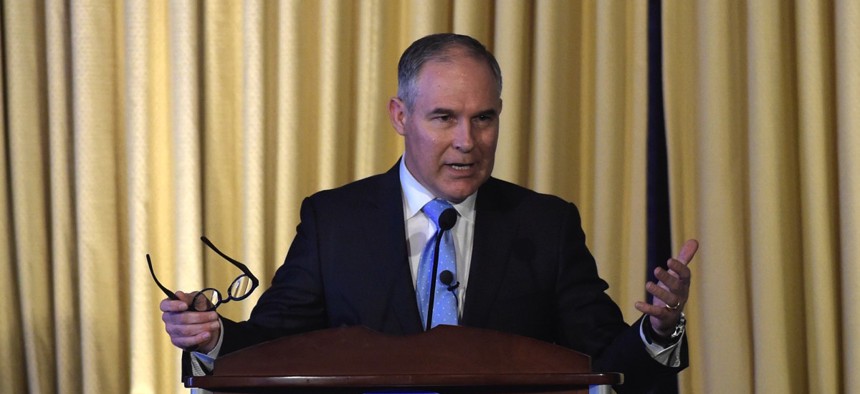Why California Is a Trump Card for Environmentalists

Scott Pruitt. (AP Photo / Susan Walsh, File)

Connecting state and local government leaders
Unique authority granted to the golden state allows it to have a profound impact on emissions regulations.
With Scott Pruitt, a close ally of the oil and gas industry, now confirmed as administrator of the Environmental Protection Agency, environmentalists are bracing for a broad assault on former President Obama’s green legacy, particularly his efforts to reduce the carbon emissions linked to global climate change.
In most of those fights, the only viable recourse for environmentalists is to contest Pruitt in court. (They can’t expect much help from the Republican Congress.) But on the critical issue of requiring auto manufacturers to improve fuel efficiency, green forces have another line of defense: unique authority that Congress granted to California under the Clean Air Act decades ago. Across the many confrontations looming between President Trump and Democratic-leaning local governments on issues from immigration to health care, the impending struggle between the EPA and California over fuel economy may be the one where Democrats most clearly hold a trump card.
After years of stalemate that blocked any increases, Obama and the auto industry reached agreement in 2009 to raise mileage requirements for cars and light trucks from around 25 miles per gallon to 35.5 mpg by 2016. (In breaking the logjam it didn’t hurt that Obama was also negotiating the federal financial lifeline that saved the auto industry amid the Great Recession.) In 2012, Obama and the auto industry reached a second agreement to raise fuel economy standards to about 54 miles per gallon by 2025. These improvements were a cornerstone of Obama’s climate agenda: his EPA projected that in 2025 improved fuel economy would yield even more carbon reductions than its Clean Power Plan targeting power generation.
California was the catalyst for the national drive to improve fuel economy through the privileged position federal law grants the state to drive environmental innovation. Facing the endemic air pollution challenges that wrapped Los Angeles in smog, the state began regulating auto tailpipe emissions in 1966––one year before the first major federal clean air legislation. Recognizing the state’s pioneering role, the 1970 Clean Air Act (signed by Republican President Richard Nixon, a Californian) allowed California, alone among the states, to obtain EPA waivers to set its own vehicle emission standards if they were at least as stringent as federal requirements. In 1977, Congress allowed other states to adopt California’s standards, rather than the national rules.
The EPA has granted California over 100 of these waivers, which have driven an array of pollution-reduction gains. That list, as Richard Frank, an environmental law professor at the University of California (Davis), recently recounted for a State Senate committee, includes the first limits on emissions of hydrocarbons and carbon monoxide and the development of the catalytic converter and the “check engine” light diagnostic system. California, Frank notes, has repeatedly provided “a model for other states, the nation and other countries.”
In 2002, California lit the long fuse for Obama’s fuel efficiency agreements when it passed landmark legislation requiring vehicles to limit their emissions of greenhouse gases-which effectively mandated the manufacturers to improve mileage performance. About a dozen other states adopted the standards, but the George W. Bush EPA blocked the California rules by denying them, for the first time, a waiver. That fight was in court when Obama took office, but it became moot when he granted the California waiver, and effectively incorporated its fuel efficiency standards through 2016 into his first national agreement with the auto companies. The process repeated in 2012: California approved new state standards through 2025, Obama granted them a waiver and essentially merged the state rules into new national rules.
Obama’s second agreement with the auto companies required the EPA to conduct a mid-point review of the standards to determine if it was technically feasible to meet the higher requirements set for the 2022-2025 model years. Just before he left office, his EPA determined it was and finalized their approval of the 2025 requirements. But in late February, the Alliance of Auto Manufacturers formally asked the Trump EPA to reconsider that review. Most observers see that as the first step toward the industry challenging the fuel efficiency mandate itself for the 2022-2025 years-and most expect Pruitt to support that request.
Pruitt’s problem is California’s second waiver from Obama: the California Air Resources Board says it provides the state authority through 2025 to implement its own carbon emission rules, which match the existing federal vehicle fuel economy standards.* That means if Pruitt and the auto manufacturers truly want to roll back Obama’s auto efficiency standards, they will need to also rescind California’s waiver for its own rules––especially since about a dozen states, cumulatively representing about one-third of all new car sales, have adopted the state’s regulations.
“At some point, they have to try to take California’s authority away,” says Roland Hwang, director of the Natural Resources Defense Council’s energy and transportation program.
No previous administration has tried to revoke a California waiver. “There is no precedent for revoking a waiver, and there doesn’t appear to be a pathway in the Clean Air Act for doing that,” says Dan Becker, founder of the Safe Climate Campaign. But Pruitt raised eyebrows at his confirmation hearing when, under sharp questioning from Sen. Kamala Harris (D-CA), he expressed clear skepticism about the waiver process.
Later this month, the California ARB plans to reaffirm its vehicle emission requirements through 2025––and to begin setting even tougher post-2025 limits to meet the ambitious overall carbon reduction goals the state approved last year. Even as the Trump Administration begins a sharp U-turn on climate, California, in other words, is putting the pedal to the metal. All involved should brace for impact.
Ronald Brownstein is the editorial director for strategic partnerships for The Atlantic, where this article was originally published.

NEXT STORY: Health Care Experiment Aims for Healthier Patients, Lower Costs





